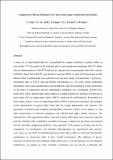| dc.contributor.author | Olm, Carsten | |
| dc.contributor.author | Zsély, István Gy | |
| dc.contributor.author | Varga, Tamás | |
| dc.contributor.author | Curran, Henry J. | |
| dc.date.accessioned | 2016-10-26T09:55:44Z | |
| dc.date.issued | 2015-01-22 | |
| dc.identifier.citation | Olm, Carsten, Zsély, István Gy, Varga, Tamás, Curran, Henry J., & Turányi, Tamás. (2015). Comparison of the performance of several recent syngas combustion mechanisms. Combustion and Flame, 162(5), 1793-1812. doi: http://dx.doi.org/10.1016/j.combustflame.2014.12.001 | en_IE |
| dc.identifier.issn | 1556-2921 | |
| dc.identifier.uri | http://hdl.handle.net/10379/6103 | |
| dc.description | Journal article | en_IE |
| dc.description.abstract | A large set of experimental data was accumulated for syngas combustion: ignition studies in shock tubes (732 data points in 62 datasets) and in rapid compression machines (492/47), flame velocity determinations (2116/217) and species concentration measurements from flow reactors (1104/58), shock tubes (436/21) and jet-stirred reactors (90/3). In total, 4970 data points in 408 datasets from 52 publications were collected covering wide ranges of temperature T, pressure p, equivalence ratio phi, CO/H-2 ratio and diluent concentration X-dil. 16 recent syngas combustion mechanisms were tested against these experimental data, and the dependence of their predictions on the types of experiment and the experimental conditions was investigated. Several clear trends were found. Ignition delay times measured in rapid compression machines (RCM) and in shock tubes (ST) at temperatures below 1000 K could not be well-predicted. Particularly for shock tubes, facility effects at temperatures below 1000 K could not be excluded. The accuracy of the reproduction of ignition delay times did not change significantly with pressure. The agreement of measured and simulated laminar flame velocities is better at low initial (i.e. cold side) temperatures, at fuel-lean conditions, for CO-rich and highly diluted mixtures. The reproduction of the experimental flame velocities is better when these were measured using the heat flux method or the counterflow twin-flame technique, compared to the flame cone method and the outwardly propagating spherical flame approach. With respect to all data used in this comparison, five mechanisms were identified that reproduce the experimental data similarly well. These are the NUIG-NGM-2010, Keromnes-2013, Davis-2005, Li-2007 and USC-II-2007 mechanisms, in decreasing order of their overall performance. The influence of poorly reproduced experiments and weighting on the performance of the mechanisms was investigated. Furthermore, an analysis of local sensitivity coefficients was carried out to determine the influence of selected reactions at the given experimental conditions and to identify those reactions that require more attention in future development of syngas combustion models. | en_IE |
| dc.description.sponsorship | OTKA (Hungarian Scientific Research Fund) grants # K84054 and # NN100523 | en_IE |
| dc.format | application/pdf | en_IE |
| dc.language.iso | en | en_IE |
| dc.publisher | Elsevier ScienceDirect | en_IE |
| dc.relation.ispartof | Combustion And Flame | en |
| dc.rights | Attribution-NonCommercial-NoDerivs 3.0 Ireland | |
| dc.rights.uri | https://creativecommons.org/licenses/by-nc-nd/3.0/ie/ | |
| dc.subject | Syngas combustion | en_IE |
| dc.subject | Detailed mechanisms | en_IE |
| dc.subject | Mechanism testing | en_IE |
| dc.subject | Mechanism development | en_IE |
| dc.subject | Laminar flame speeds | en_IE |
| dc.subject | Burning velocities | en_IE |
| dc.subject | High pressures | en_IE |
| dc.subject | Shock tube | en_IE |
| dc.subject | Kinetic mechanism | en_IE |
| dc.subject | Low temperatures | en_IE |
| dc.subject | Carbon monoxide | en_IE |
| dc.subject | Mixtures | en_IE |
| dc.subject | Oxidation | en_IE |
| dc.subject | Hydrogen | en_IE |
| dc.title | Comparison of the performance of several recent syngas combustion mechanisms | en_IE |
| dc.type | Article | en_IE |
| dc.date.updated | 2016-10-20T08:49:55Z | |
| dc.identifier.doi | 10.1016/j.combustflame.2014.12.001 | |
| dc.local.publishedsource | http://dx.doi.org/10.1016/j.combustflame.2014.12.001 | en_IE |
| dc.description.peer-reviewed | peer-reviewed | |
| dc.contributor.funder | |~| | |
| dc.description.embargo | 2017-01-22 | |
| dc.internal.rssid | 9368347 | |
| dc.local.contact | Henry Curran, Dept Of Chemistry, Room 215, Arts/Science Building, Nui Galway. 3856 Email: henry.curran@nuigalway.ie | |
| dc.local.copyrightchecked | No | |
| dc.local.version | ACCEPTED | |
| nui.item.downloads | 488 | |


